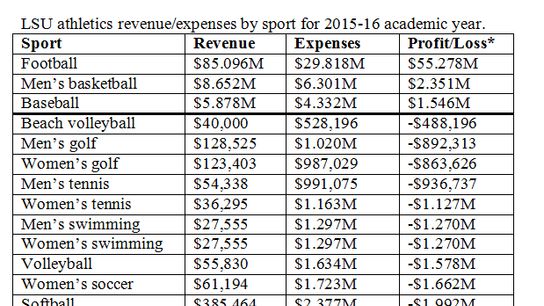Thanks to The Advocate's Ross Dellenger, we got a peek under the hood at LSU's financials on Monday.
Financial documents show in the 2015-16 athletic year LSU booked $141 million in revenue against $129.8 million in expenses, good for a tidy $12 million profit. Chief among that $141 million revenue was the $85 million brought in by the football program against nearly $30 million in expenses.
Those who have been around the block a few times can see the headlines screaming across the internet as they read this: LSU FOOTBALL KEEPS $55 MILLION IN PROFIT WHILE PLAYERS GET NOTHING! BURN THE SYSTEM!!!!
First of all, that $55 million figure is likely inflated. For instance, we know LSU recently completed an $80 million renovation of Tiger Stadium and is currently working on a new $12 million nutrition center. Neither of those items are counted against LSU's football program specifically.
Still, let's be aggressive and say the football program really took home $40 million in profit over the 2015 season. Either way, it's a lot of money. However, it doesn't exist in a vacuum.
If college football players are to be paid, that money is likely coming from some of these programs that rely on football to remain on campus.

Go ahead and pick out which programs you'd like to cut and how you'd square the lost scholarships with Title IX.
Many in the "players get nothing!" camp maintain a scholarship counts as "nothing" while young Americans have taken on more student debt than any other generation in the history of this nation.
Total U.S. student debt hit a record $1.31 trillion last year, the 18th consecutive year Americans' education debt rose, according to the Federal Reserve Bank of New York.
Outstanding loans taken out for higher education have doubled since 2009, data show. No other form of household debt has increased by as much since then. In fact, of the six major categories of consumer debt tracked by the New York Fed, only student loans and auto debt have increased since year-end 2008 (total auto loans are up 46 percent). Total household debt has fallen by 1 percent.
In a knowledge economy, a free education is clearly worth something. So, too, are the free meals, the free housing, the free apparel, the professional strength training, the professional development -- football and otherwise -- the professional nutritional care and the professional medical care that players receive in conjunction with their scholarship.
A number of studies say big-time college football players are worth high six-figures annually, but those studies don't take into effect players are "worth" that much because they are big-time college football players.
Leonard Fournette has a credible argument against this; clearly, his performance and profile carries a worth beyond his scholarship. Lanard Fournette does not. In college sports, interest and worth come from the uniforms the players wear first, and the people in them second.
Caveats to this stance exist. You'd have a hard time finding someone in 2017 who doesn't believe, for instance, Lamar Jackson shouldn't get a cut every time every time a Louisville No. 8 jersey is sold. But even still, Jackson's value comes from the fact he plays for the Louisville Cardinals of the ACC, not the Louisville Lions of some fictional NFL minor league or the Saskatchewan Roughriders of the CFL.
But, on the whole, in the era of 24/7 training tables and cost-of-attendance scholarships, big-time college football programs still give more value to most players than those schools receive in return.
